Public Demonstrations and Living Archaeology Weekend
Today we are so lucky because regular PLY contributor Christina Pappas is visiting us on the blog! Read on as she takes us on a virtual tour of Living Archaeology Weekend in Kentucky.
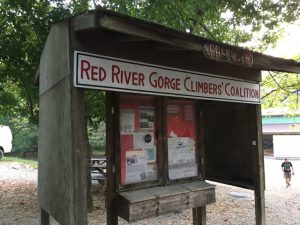
A notice board for rock climbers at the Red River Gorge.
The Red River Gorge in Kentucky is best known as a destination for world-class rock climbing, but during the third weekend of every September it’s better known for something else. For nearly 30 years, Living Archaeology Weekend (LAW) has been held in the Red River Gorge. For two days, demonstrations teach about American Indian and pioneer technologies and lifeways, archaeology, and protecting cultural resources. Friday is reserved for school children, and this past year nearly 1,200 4th and 5th graders participated in LAW. On Saturday, the general public is invited to join in on the fun. Demonstrations range from atl-atl (spear) throwing to long rifle hunting and it’s hard not to learn something new. Most people don’t know how important textiles were in ancient and early historic lifeways, but a group of us at LAW are changing that.
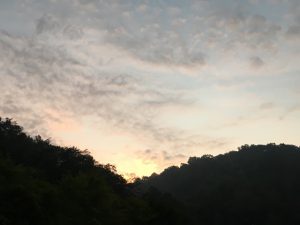
Sunrise at the gorge the morning of LAW.
This was my third year demonstrating ancient spinning and weaving at LAW. I’m still new to this method of demonstrating and teaching; every year feels completely different. The weekend is a whirlwind of activity. My first year at LAW, I assumed this would be like any other event where I demonstrated ancient textile techniques. There would be some polite interest and a few questions, maybe a handful of folks who would want to dig a little deeper into the technique. LAW is anything but. On Friday, the school kids are an explosion of energy and excitement. I always start by asking them what ancient people would have worn thousands of years ago. Animal skins are always a standard answer and I love to see their astonished faces when I show them the soft fabric made from local plants used for clothing. I show them how to twist plant fiber into yarn and then they get to try prehistoric weaving. The boys usually become shy and let the girls take the lead. This year was different. My husband demonstrated the weaving and once the boys realized this wasn’t just ‘woman’s work’, they had as much fun, and success, weaving
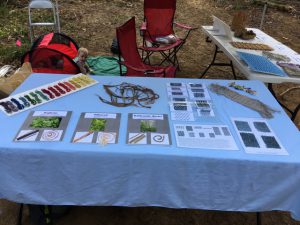
My demonstration table at LAW. I have examples of different types of textiles, some plants used for fiber, and a rainbow of color from natural dyes. The colors possible from natural dyestuffs always impresses my visitors. Also note the adorable baby playing in the back.
What makes LAW really challenging is that you only have a few minutes with each group of kids. I have to summarize 40,000 years of textile technology and teach how to make yarn and how to weave in 10-15 minutes. It’s a bit exhausting but in the end it’s worth it. My demonstration breaks so many misconceptions for these kids. Ancient peoples wore clothing as vibrant and interesting as we do that told as much about them as our clothes tell about us. LAW helps these kids learn that the stereotypes about ancient peoples they have grown up with are often wrong. It
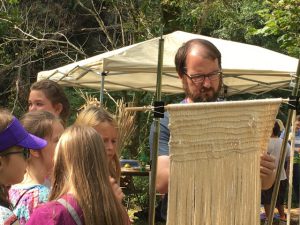
My husband Chris demonstrates a type of prehistoric weaving, twining, to school children. The boys always seem reluctant to try the weaving because ‘that’s what girls do’ but seeing a man take the lead on the actual weaving inspired them to give it a go.
I’m not alone in my textile-themed demonstrations. Robin McBride Scott demonstrates basketry techniques that have been used since ancient times. A self-taught basketmaker, Robin has been demonstrating at LAW for 13 years. Like me, Robin has found that the kids at LAW arrive with a lot of misconceptions about the ancient past. She tries to get them to see baskets as tools and not just a decorative art piece on the shelf, how changes in the basket weave can change the strength and use of the finished object, and the role baskets played in our technological evolution.

A great wheel is the show-stopper for kids at the historic spinning demonstration at LAW. Most of the kids have never seen a spinning wheel in person, let alone a great wheel.
LAW has become one of my favorite fiber-related activities all year. It is exhausting, but it’s always so much fun. Demonstrating at LAW has made me really think about what is most important for people to learn about spinning and weaving. When you only have a few minutes of a child’s attention, you have to make sure what they take away from you matters. Knowing that ancient people spun and wove and that the stereotypes are wrong is what matters to me.

Chris is an archaeologist by day and a fiber fanatic by night who is happiest when she can be both at the same time. She lives in Kentucky with her husband, adorable baby girl, and two crazy beagles.


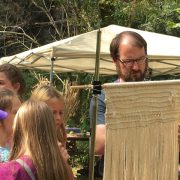

Leave a Reply
Want to join the discussion?Feel free to contribute!